PROPERTIES NOT OWNED BY ETON COLLEGE (TO THE PRESENT)
THE PIDDLE MANOR AND FARM
To the south of the Manor of Piddlehinton lies a block of land within the parish, which is the Manor of Little Piddle. In 1086, as recorded in the Domesday Book, it was part of the Royal Manor of Puddletown. On several occasions the lands were included in the possessions of Cerne Abbey as well as of Milton Abbey. After the Dissolution, the land was granted in 1545 to William Riggs, and in 1547 to Robert Kelyway. The other remaining areas were held by the Count of Mortain. These areas also included the Manors of Combe Deverel and North and South Lovard.

Although at the time of Domesday many of these manors were thriving settlements, today they are represented by a single farmhouse (in the case of Little Piddle), and rough outlines in a field at North Lovard. The blame for such decline is often laid on the plague which reached Great Britain in the 13th century.
From early references it appears that Little Puddle was divided into two, and it is suggested that the old parish boundary between Piddlehinton and Little Puddle (then in Puddletown) - was the line of the Manor division. This boundary runs right through the earthworks which cover 32 acres and represent the settlements of Little Puddle and presumably the other Manor known as Combe Deverel. The Manor can still be located by field names which even in the 19th century bore the name of the ancient owners, the Deverels. The Manor would probably coincide with the modern-day Holcombe Farm.
There is evidence of a chapel at Little Puddle in the 14th century which gave the church an interest in the Manor. The church was allowed for its upkeep, a portion of the tithes of hay in Little Puddle, and pasture for '100 sheep, 10 oxen, 5 cows and 10 hogs'. After the Dissolution, the Manor passed to Thomas Hennage, except that the vicar of Puddletown reserved rights to pasture 100 sheep there.
In 1288 we are told of a 'certain hall' which consisted of 2 rooms, a grange, a stable and a kitchen, as well as the other message and houses of the crofters. By 1333, 7 taxpayers were recorded, indicating some decline even before the Plague. However by 1539 only 2 men were recorded and again in 1662. In the 19th century only Little Puddle Farmhouse remained on this site. It is now known by the name 'Lawrence Mead', a name taken from the meadow which is noted on the Tithe Map. Thomas Meggs, the tenant of Piddlehinton demesne, owned the farm by the end of the 18th century. Prior to that, a Kellaway had been farming here so perhaps, as the tenancy of the demesne passed from Kellaway to Meggs and then to the Mayo family, so too did the ownership of Little Puddle.
William Mayo of Steepleton bought Little Puddle in the early 19th century, perhaps upon Thomas Meggs death in 1819. In 1821 Eton records note that William Mayo had taken over the lease of Manor Farm at Piddlehinton. In 1828 he was living at Little Puddle and the farm stayed in the Mayo family until 1941. The family acquired land in other parts of Dorset so that younger brothers and sons rented Little Puddle. In the mid-19th century, William's son (another William) was renting it to his brother Charles. When the latter retired, unmarried, William's third son, (Charles again!) took over the tenancy and this is the agreement between father and son dated 6 April 1871. Charles died aged 44 years in 1893, leaving a young family.

The yearly rent for the farm was £400. The tenant agreed to manage the farm on a four-field system and to use all the hay and straw on the farm. The landlord was to keep the thatching and buildings in repair although the tenant had to obtain the materials. There is a Valuation of the farm from this date. This included 900 ewes with much equipment for their management. Naturally most of the land was down to grass but in cultivation were 60 acres of wheat, 42 acres of barley and 24 acres of oats. There were 10 carthorses.
In 1874 the family acquired more land when the elder Charles died. He is photographed here on the left with Rev Roper. His brother (William of course!) bought Holcombe and Blackhouse Farm from the trustees of Charles. When he died a year later, the next William, who inherited Little Puddle, gave notice in accordance with his father's will that he would take up the option of buying the farms for £5000. Thereafter, his brother Charles' rent for Little Puddle, Holcombe and Blackhouse Farms was £700 a year.
In 1880 the Mayo family held a large sale of timber. We do not know whether this wood came totally from Piddlehinton estates or included wood brought in from other Mayo farms. Perhaps we can assume that most came from this farm or the sale would not have been held here. If this is so, then some considerable amount of woodland must have been felled. The 132 lots made £107.
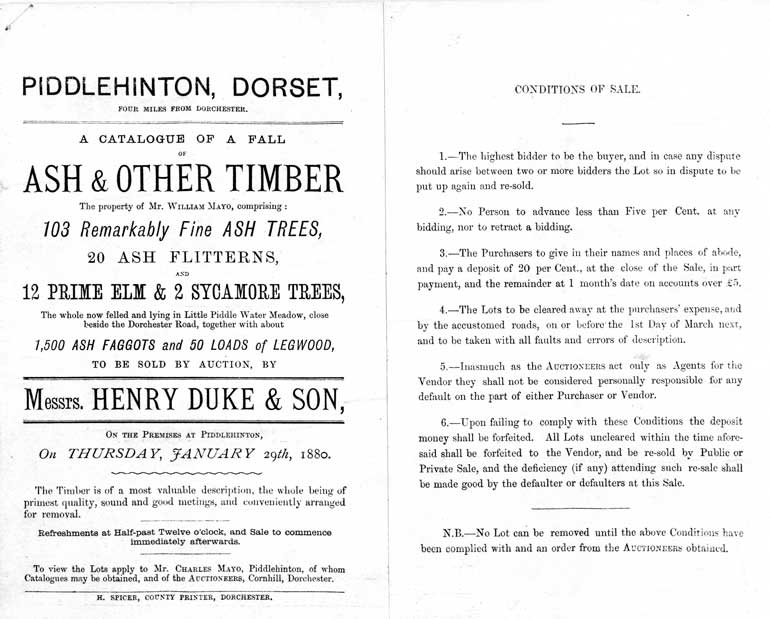
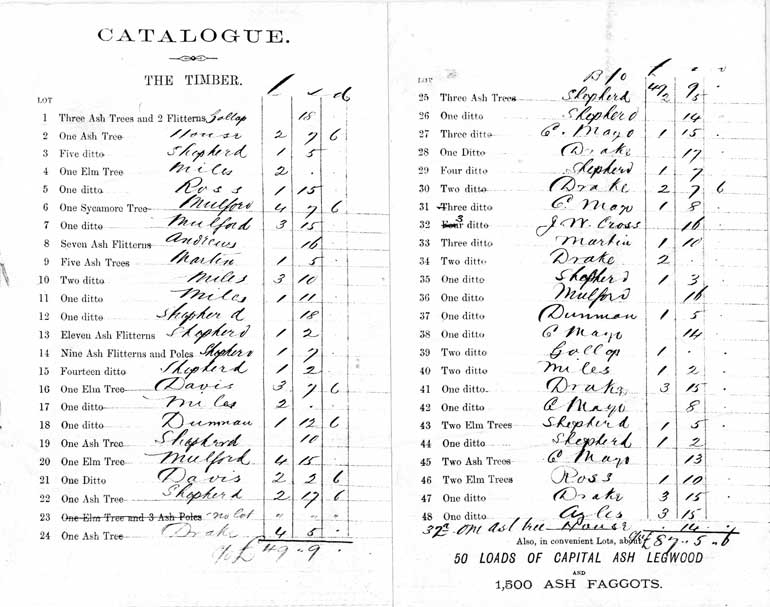
A sheep sale was held in 1886 when Charles Mayo quitted the farm. The auction included over 1000 Dorset Down sheep and lambs, 6 carthorses and a hack horse. A prime carthorse fetched £45 and his harness £16. The sheep were bred by Charles Mayo using rams from the Watercombe flock; they were described as coming from 'one of the healthiest farms in the district'. Twenty 4 or 2 teethed ewes made about £45. As a comparison, twelve 4 teethed ewes sold in the sale of 1941, made £58.

The fourth William Mayo at Little Puddle also died young in 1913 aged 50. From his obituary in the parish newsletter he seems to have been a highly respected member of the community. He had no children and the estates passed into the hands of his younger brother Henry George.

Until 1941 Henry George Mayo, pictured here outside Little Puddle Farmhouse, farmed the lands although he lived at Corton. Ben Cheeseman remembers that he rode from there to Little Puddle on horseback, always wearing his bowler hat. The family had not lived in the old farmhouse. By 1941 the farm was mainly pasture for sheep and a dairy herd. Arable included rye, barley, wheat, oats, vetch and mangolds, most of this grown for feeding. When Mr Paul bought the farm it became almost entirely arable, although today the Hollands family have introduced a dairy again. Also included in the 1941 sale were a cider mill and press and various barrels, indicating that perhaps cider was made at one time from the apples in the orchard behind the farmhouse.
In a Valuation of 1921 only 15 heifers were recorded, but by the time the farm was sold, the herd had matured and been built up to include 25 dairy cows, 23 heifers and 5 calves as well as 5 bulls.


The Cheesemans lived and worked at Little Puddle for many years; before that they had worked at Muston. Fred Cheeseman lived in a cottage on Little Puddle Hill which has since been pulled down. Fred was the carter, Harry Cheeseman was the foreman, and he lived next door. The picture shows Fred ploughing at Holcombe in 1941 using 3 of the 4 horses in his stable. In 1921 there were 10 cart-horses kept on the farm but only 7 by 1941 - Fred Cheeseman's stable of 4 and there was another stable of 3 at Holcombe. They also kept a 'Half-way Horse' used for both hunting and working.
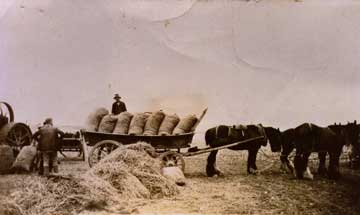
Fred Cheeseman is pictured here with the threshing contractor Percy Pile who came to the farm in the 1930s from Godmanstone. In 1921 arable included 64 acres of barley, 16 of rye, 80? of oats and 16 of wheat. The hay and straw are piled into loose ricks. In 1921 there were 15 ricks and a large supply of straw thatch. Ben Cheeseman was given rides in an old car with a hay sweep on the front - this was sold in 1941 for £9.
Bob Gregory worked for the Mayos to maintain the water meadows which were quite fine in this area. When the hatches were opened to let the water through, the gullies yielded up stranded trout and eels.
By 1941 there were 6 houses on the farm - 2 on Little Puddle Hill and 2 at Holcombe were described as 'of recent construction' and were occupied in 1881 by farm labourers. These are now gone. During the Second World War 4 houses on the farm were requisitioned. In 1881 there was another farmhouse described as 'old and thatched' which was occupied in 1881 by 2 families. It is shown as 'Whitehall Cottages' on the 1902 OS Map and was derelict by the 1930s.
NAPPERS MITE FARM (ALMS FARM), BOURNE FARM and MUSTON MANOR
NAPPERS MITE FARM
This farm, included in the Puddletown parish until the reform of the parish boundaries, has an unusual history although we can only trace it from the 17th century. In 1595 Henry Moleyns held at his death 114 acres of land, a quarter of the manor of Little Puddle, which was later bought from his family by Sir Robert Napper or Napier of Middle Marsh hall. When he died in 1615 he had almost completed an almshouse in Dorchester which his son Nathaniel was instructed to (and did) finish. Sir Robert stated that the farm at Little Puddle was to be leased at a yearly rent of £50 and that money was to be used for the 'sustenation and maintenance of the almshouse and ten poor men'. This almshouse, with its distinctive building can still be seen in South Street in Dorchester and is still known as 'Nappers Mite' despite being redeveloped as shops.
In 1839 a Piddlehinton farmer John James was farming 136 acres here, but by the 1860's and into the 1880's it was leased by the Mayos of Little Puddle in conjunction with Bourne Farm. They seem to have sub-let it to the Saunders family who rented Muston. The Saunders quitted the farm in 1892 when Mr Harold Waterman, who already held the tenancy of Bourne Farm, took over the 168 acres of Nappers Mite Farm as well. The farm itself has been known by various names, mainly derived from its charity connections - Alms Farm, Alms Barn, aims Barn and latterly Puddletown Farm.

Harold Waterman was advised to take up farming for his health. After studying as a farm pupil in Kent he came to Piddlehinton when he was 23 to work as a pupil at Manor Farm. Here he lodged with the Riggs family at Manor Farmhouse. In 1890 he secured the lease of Bourne Farm from the Churchill family and from May 1892 he farmed Nappers Mite as well on a yearly tenancy. For a year and a half Harold Waterman ran both farms with mixed fortune. It was a time of agricultural depression and the yearly tenancy brought insecurities. He ploughed a great deal of time and effort into both farms under the impression that he would continue to farm them for several years. He lived at the Manor Farmhouse whilst waiting for a new house to be built at Bourne (the farmhouse there having been divided into farm-worker's dwellings). By 1894 he wanted to marry Elizabeth Wright of Dorchester and as the house did not materialise, he took the tenancy of a farm at Alton Pancras where a house was available. He left Bourne Farm in 1894 but kept on the Nappers Mite Farm until the end of 1896.
He helped to haul the materials for the building of the new Wesleyan Chapel in Piddletrenthide in 1894 and later commissioned the organ. He was both the organist and the secretary for the Wesleyan Methodists. He died in 1923 and both he and his wife are buried in Piddlehinton.

This agreement detailed the valuation of hay, straw and tillages left at Nappers Mite Farm when quitted by the Saunders' and which Mr Waterman had to pay for. Over 90 acres were listed as arable although 8.5 acres of this were 'not cropped' and Mr Saunders was paid compensation for this. Mr Waterman continued to keep this land in Higher Plain as pasture but later during the First World War, prisoners of war were pulling flax there. Apart from the buildings described here, there were two cottages, inhabited in 1881 by a shepherd and a carter and in the 1920's by Tom Pearcy and Herbie Stroud farmworkers for the owner - then Clement Tory. In 1929 they were burnt down. During the 1930s Mr Tory swapped the land on the lower side of the road for some land belonging to Mr Vincent who lived at Muston. The higher half of the farm continued in the Tory family, sown with cereals until 1937. Then it was requisitioned and an Army Training Camp built there and Mr Tory was paid £31 an acre.
BOURNE FARM
Mr Waterman's accounts for 1891 are from Bourne Farm. The two tenancies seem to have been held in conjunction with each other for some years, although they had quite different owners. Bourne Farm ad been bought by the Churchill family, who owned the Muston estate, some time prior to the early 19th century. In 1824 a Valuation of Puddletown Lands details Bourne as a mixed farm of 164 acres tenanted by Mr George Burt who was still there in 1839. Again the Mayos rented it later with the Saunders family paying them rent. During Mr Waterman's time at Bourne he built up the road from Bourne Drove across the field 'New Piece' to the Bourne buildings and was due compensation according to the terms of the Agricultural Holdings Act. He also had the pond at Bourne remade and as the water supply was always a problem, especially during droughts, as in 1892, he paid much attention to the wells.
Mr Waterman's accounts give us an insight into farming at the end of the last century.

This page shows subscription to the Corn Exchange another to Walter Lovelace's Sparrow Club. Mr Waterman employed a lot of local casual labour, some of whom are listed here. As a member of the Puddletown division of the Technical Instruction Committee, he kept an interest in his employees and entered them in competitions. Joseph White was entered in a 'Hoeing and Hedging' competition and Samuel Stack in the 'Shepherding'. He dealt with Thomas Wightman, the butcher at Piddletrenthide and other craftsman and suppliers from the village and Dorchester including Ensors the auctioneers. Some grass and clover seed and maize were bought from London, and colts bought at Woodbury Fair. The farm was run on a mixed basis. As well as having a dairy, Mr Waterman sold pigs locally, and Dorset Horn sheep, poultry and eggs at Dorchester Market. Rabbits were also an important 'crop' and continued to be so until after the Second World War. Rabbit catchers, or the farmers sons, were employed to ferret and net the rabbits during the night. Frank Dare caught 120 one night at Bourne, between the wars during the 1930s. Mr Waterman also had barley to sell to Hall and Woodhouse Brewery at Ansty and some straw which he sold for thatching.
THE TORY FAMILY AND MUSTON MANOR
Clement Tory bought Muston Manor and its 980 acres of farmland from the Trustees of William Churchill in 1906. Although he did not live in the farmhouse, he took an active part in the farming of the land.


These photographs of steam threshing and binding were taken on Clement Tory's farm about 1918. The Overtine tractor shown here was later buried on land, now part of Lea Farm. Rex Lovelace later dug it up to retrieve the large water tank, but the rest remains buried to this day.

When Clement Tory died on 4th February 1940 he left 2700 acres stretching from Dorchester to Melcombe Horsey. All the land was sold off and this advertisement from the Dorset County Chronicle on August 15 1940 shows its location. It sold for £7 an acre. Clement Tory's sons Philip and Edgar bought part of the estate at Piddlehinton, Edgar Tory buying Bourne farm (which he and his wife Freda, farmed for 23 years). Philip Tory married Nancy Lovelace and they lived at Mulletts, just over the boundary into Piddletrenthide. Edgar later bought Philip's land.


Doles Wood Plantation, where these photographs were taken in the 1950s, was bought by Clement Tory and when sold to a Mr Pentelow in 1940 it made £325. Edgar Tory bought it back five years later for £1 more! The first combine harvester was bought during the Second World War. To qualify for a combine 400 acres of corn had to be cultivated; Rex Lovelace and Edgar Tory between them had the required acreage and together they bought a Massey Harris for £1058 and paid an extra £80 for the pick-up reel. It arrived in boxes from Canada and was assembled by Reg Cosh who also drove it. It was petrol driven and needed two people to operate, one behind the driver was the 'bagger' who had to place and remove bags from 4 outlets - two for the main corn, one for tailings and one dustbag. One time this dust ignited and the combine caught fire. After 6 years Edgar bought out Rex's share and the combine eventually finished its days in the trees at Doles Wood.
From 1944 the boys from Poole Grammar School helped with the harvest, the Torys were issued with pots, pans, blankets etc to help cater for them. Enough barley was cut to make 41 ricks, these were thatched. Sam Stockley was the hedger and thatcher.
Mrs Tory can remember the water meadows being maintained and used. Using a system of hatches the rivers were dammed in the early spring and the flooding filled the ditches, allowing early grass to grow. Puddletown was renowned for its water meadows and those in the 'Puddletown' parts of Piddlehinton are far superior to the others.
MUSTON
Clement Tory bought Bourne Farm from the Churchill family in 1906. But Bourne was included in a large parcel of land known as the Muston estate and included: the ancient manor of that name which lay to the south of Little Puddle yet was in the parish of Piddlehinton; and a small manor again to the south called North Lovard.
Muston as we have seen, was held by the monastery of Cerne and from pre-Domesday was let to a family who derived their name from their religious landlords. The 'de Moustirs' family were still there 300 years later and so the manor itself became known as 'Mustereton' or 'Muston'. After the Dissolution the manor was sold with other Abbey lands to John Bartlett alias Hancock and from this family it was bought by John Churchill of Stinsford in 1609.
Gardeners Cottage at Muston may have been the Dairyhouse mentioned in the 1881 census. For a few years the Gale family lived here. A row of 6 "Muston Cottages" are also mentioned in 1881 but there was a fire a the tun of the century and the 1928 map shows a shortened row which (in 2013) still stands in a condemned state.

The Gale family were carpenters and for a while lived in the cottage at Muston. They later moved to Piddlehinton. The line up here is of Fanny Gale, and her daughter (perhaps Ethel), John (wearing a big hat) and the man in the white apron may be one of the workmen. When they moved there, Mr Burch had a sawpit dug. Mr Gale would cut his own wood, then top off the limbs and haul the trunk to the sawpit. The log was secured and he would stand on top with one end of a crosscut saw while the helper stood in the pit under the log operating the other end of the saw. The dust fell down on to the man below who wore a net over his hat, perhaps an old curtain. Perhaps this is a large 'saw hat' that Mr Gale is wearing in the photograph. If he was short-handed Dolly his daughter had to go into the pit to help out! The wood was afterwards planed by hand and for fine work it was all hand-polished. Mr Gale built wagons, making everything himself, even the iron rims on the wheels, and his name on the side in his own beautiful writing. Like any other boys, John Gales sons were often up to mischief and once, 2 of them painted Mr Burch's pig red, white and blue to honour King Edward VII's Coronation!
THE CHURCHILL FAMILY
The Churchills have the longest known connection with Piddlehinton of any family.

They originally came over from Normandy with William the Conqueror. From them were descended not only the John Churchill who bought Muston Manor in 1609 but also the John Churchill who became first Duke of Marlborough and, through him, Winston Churchill.
Over the centuries, many Churchills were baptised, married and buried in Piddlehinton church. Several Churchills of Muston were High Sheriffs of the County of Dorset.

The Rev William Rush Hallett Churchill (right) 1774-1847 (he adopted the middle names), rector of Winterborne Stickland and his wife Martha (left). He inherited this large estate and added to it by buying Black House Farm after Enclosure, also investing in a lot of other property in the village, both farmland and houses. He also owned West Lodge for a short time after forclosing on the mortgage of Stephen Iles and still held land there in 1841. He did not live at Muston Manor but took a great interest in his estates.

Most certainly the Churchills built Muston Manor in the 17th century, but within 80 years they had moved into Dorchester, having bought Colliton, now the site of County Hall. The house continued to be rented by other members of the Churchill family and the original building would probably have looked like this water-colour painting (left) from around 1800. At some time it acquired a ceiling panel from Colliton House and much later a stone fireplace surround from Waterston Manor.
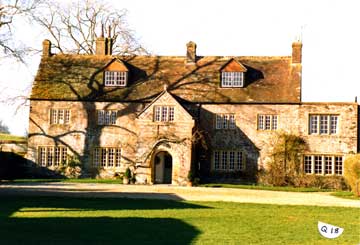
Sometime after the watercolour (above) was painted, the manor was altered and extended. The recent photograph shows the higher roof.
The Churchill family owned Muston Manor until 1901 when it was sold to Clement Tory, although Commander and Mrs Churchill were able to buy the house back again in 1915. They were driving through the valley looking for somewhere to rent before Commander Churchill went on overseas service. They knocked on the door at Muston and Clement Tory readily agreed to them renting, and later buying it. He was not living there himself at the time.
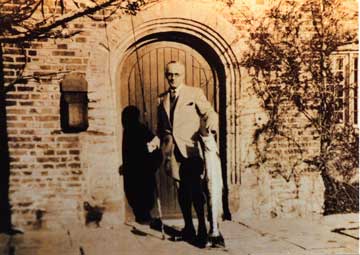

Commander Kenneth Churchill and his wife Margaret lived there with their family for the rest of their lives and became prominent and respected citizens of the village. Commander Churchill was for many years a Church Warden and School Manager. He owned and ran Victoria Park Creamery in Dorchester, now Unigate. His wife, Margaret, was an enthusiastic supporter of the Women's Institute. Among many other activities she organised a home knitting industry in the village. Susan, their daughter, founded the Piddlehinton Brownies in 1940. She married Mark Williams of Bridehead in 1941. Because of the war, their wedding was not in Piddlehinton, as had been that of so many Churchills in previous generations, but in Dorchester, on a Saturday morning. This was so that their many friends could combine coming to it with a Dorchester shopping trip making double use of their scarce war time petrol coupons. Commander and Mrs Churchill's younger son, George, died as a child in 1927. His parents installed the Communion table, reredos, panelling and stalls in the church in his memory.
Their son John sold the house in 1976 after his father's death. It was bought by Mr and Mrs OBN Paine who lived there until approx 2000.

Prior to the Second World War the young Margaret Jeanes, who lived at Piddlehinton, left school to work and live at Muston Manor, first as housemaid and then as parlour maid for Cdr and Mrs Churchill. Also employed were a cook and a housemaid as well as the gardener who lived in the "Gardener's cottage". Margaret was well looked after there, working from 7.00 am until 9.30 pm with half a day a week and every other Sunday off. On her half day, she walked to Piddlehinton for tea with her mother and then walked back to Muston again, that was the afternoon gone! During the war Cdr Churchill was called on to the Reserve List and went to Middlesborough. Mrs Churchill stayed at Muston and did VAD work. There were some evacuees billeted at the house and also the padre from the Camp tenanted part of the house. The house staff was reduced to just Margaret until she too was called up.
The farm itself was tenanted. From at least 1845 the Saunders family were farming here and during the 1880s they were living in the manor as well. Probably from 1892 Arthur Burch became the new tenant and he continued there until the estate was sold. Clement Tory kept a Farm Bailiff and then during the First World War it was bought by another local farming family. The land to the south of the road, now known as Muston Farm, was bought by Robert Vincent who was already farming at Manor Farm, Waterston. Of his seven children, four died young of ill-health but two sons and a son-in-law were all farming and the family acquired first Muston - which was farmed by Gaius, and then Lea Farm for Howard Charles Vincent.
During the War, two Land Army girls, Joan Davis and Irene Cordier worked at Muston. Unfortunately Joan was killed in an accident.

NORTH LOVARD
The most southerly manor of the parish was that known as Louvard or Lovard. This name applies equally well to land in both Piddlehinton and across the boundary in Puddletown. On the Tithe Maps for both parishes the fields in this area were still referred to by this old manorial name. The parish boundary acts as a division so that we can now call the areas North and South Lovard but earlier references fail to distinguish between the two.
There are two sets of archaeological remains, those in Piddlehinton being on the North side of the river at Snowdrop Corner. Although there has been some destruction by the building of the road, there appear to have been six closes which all possibly contained platforms for houses. But 1327 there were only seven taxpayers recorded and they would have been living in the south settlement as well. This area is based around Higher Waterston Farmhouse which was certainly the only house inhabited at Lovard in 1662. The ownership is equally difficult to relate, but once again Christchurch priory had a say here. The Cheverell family held it for many years and perhaps after the Dissolution they bought the manor, for in 1586, Hugh Chaunterell of Chauntmarle sold the farm to William Churchill of Dorchester. He was the father of John Churchill who later bought Muston. In 1622 it comprised 20 acres of land, 18 acres of meadow and 100 acres of pasture.
LEA FARM
Clement Tory bought this area of land with the rest of the Muston Estate in 1906. In 1918 he tried to sell some of his estate but land prices were low and many of the lots were withdrawn. However Robert Vincent bought for £45 an acre, Waterston Mead - previously Lovard mead and later known as Horse Ground. He built Snowdrop House here for his retirement. The meadow is interesting in that the parish boundary runs through it and yet deviates from the river that it followed to the road on Muston ground and rejoins at the farther end of this field. The Puddletown side of this meadow shows the remains of water meadows and no doubt the river course was altered to construct them. Later, the Vincents bought the higher 60 acres, also referred to earlier as Lovard fields and made a farm for Howard Charles Vincent. He moved into Lea Farm in 1937.
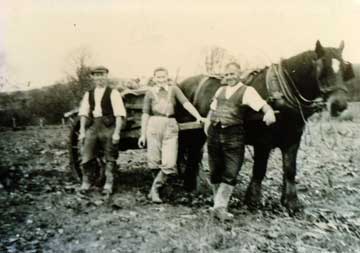
This photograph shows Charlie during the Second World War with his farmworker Roy Percy, and Margaret Jeanes, the land girl who had been called up in 1942 and started work at Lea Farm on 1 January 1943. The horse, Prince, was one of two kept on the farm. They were used to pull the two spring wagons and also a large hay wagon. Margaret worked from 6.00am until 5.30pm and was paid 1s an hour. The farm was mainly dairy and for 18 months she milked until her hands reacted with milking eczema. Potatoes were also grown because they attracted a government grant, and the Italian Prisoners of War from Dorchester helped with the planting and digging. Some wheat and a 'mixture feed' were grown. Charlie Vincent continued to farm at lea Farm until his retirement in 1959.
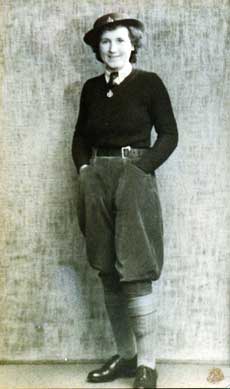
Margaret Jeanes looked after the land girls in the hostel at Piddletrenthide for 6 months before going to Lea Farm. She lived in for a short while until she met her husband-to-be (who was stationed at the Camp), at a dance in Piddletrenthide. Then she preferred to stay with her parents and cycle to work so that she could see him more often. All too soon his 15th Medium Royal Artillery Regiment swapped camps with the Americans, who found Warden Hill, Evershot, too cold! He was soon off preparing for D-Day, but the couple managed to marry at Piddlehinton in 1945 while he was on a 6-week Instructors Course at Rhyll. The Boardmans were reunited in Manchester after Margaret's demob on 1 January 1946.
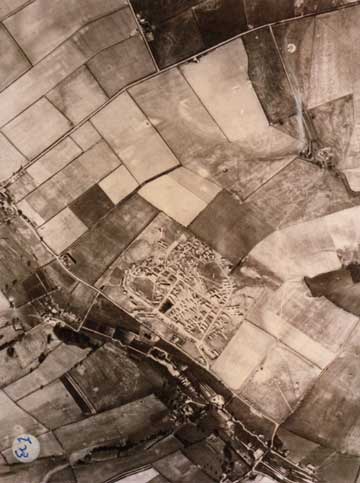
Here we can see all the farms in this southern area of the parish. Little Puddle is below and to the left of the army Camp. A small lighter square to the left again is Whitehall Cottages, then derelict. To the north on the road is 'Dales Corner' and the line of the track there which can be followed in field boundaries is the old boundary between Piddlehinton and Puddletown. The southern boundary bends from the right-hand side and disappears in the Camp, the northern part of the camp being built on Nappers Mite Farm and Puddletown Farm buildings are on the side of the road. Bourne Farm is above and to the right. Following the course of the river from the Camp, Muston is to the south and Higher Waterston (South Lovard) on the bottom of the photograph. Lea Farm, adjacent to the North Lovard remains, is in the bottom right hand corner. The photograph was taken in April and the watermeadows are well flooded.